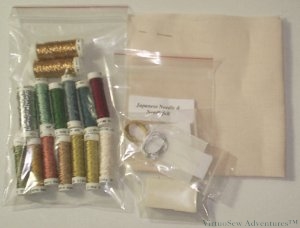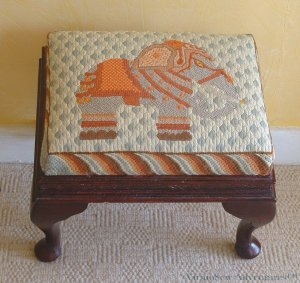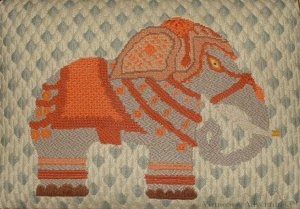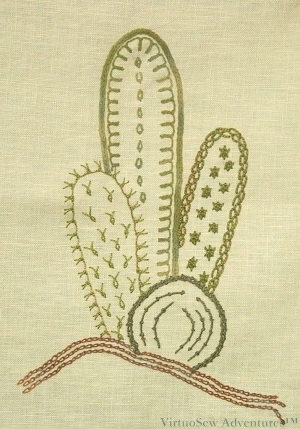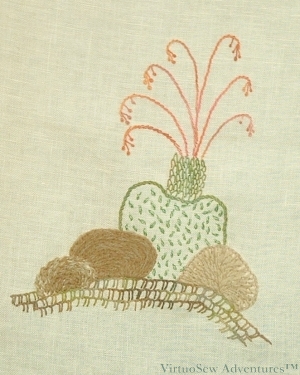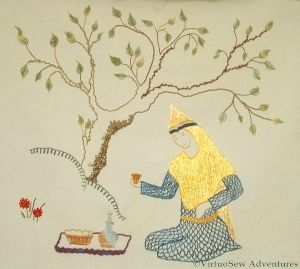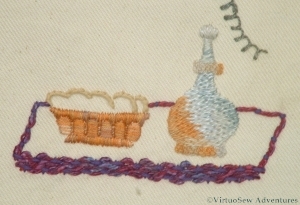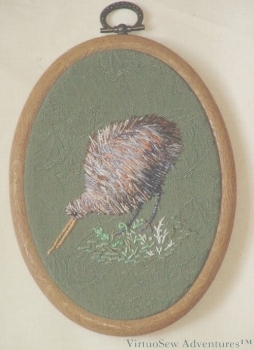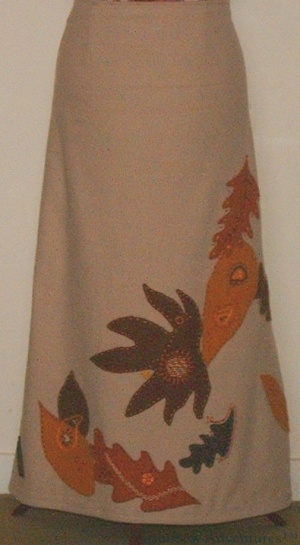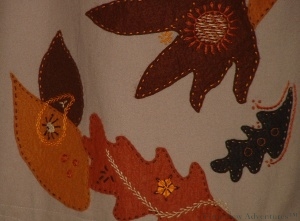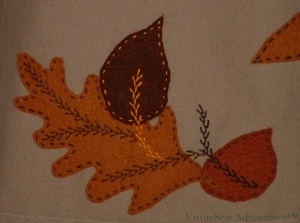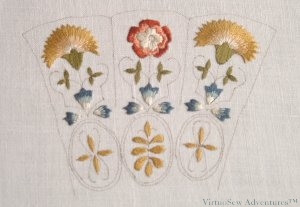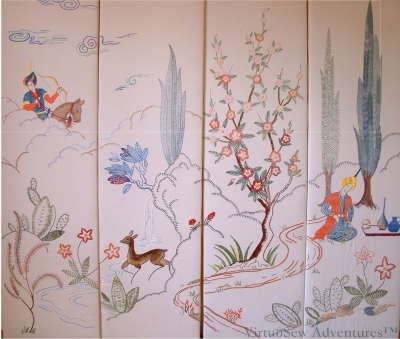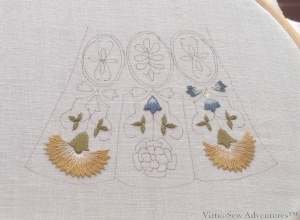Category: General Embroidery
Starting Another Course
I decided to follow another Thistle Threads Online University course. This time it is the Tudor and Stuart Gold Master Class, and my first materials kit arrived today. There is more of that lovely Au Ver A Soie, and a lot of gold thread for practising with, as well as for working on the spot sampler.
The real attraction of this course to me is that Tricia has worked out how some of the ornate and now mysterious stitches of the period would have been worked. The stitches shown on the video look fascinating, and as well as providing instructions, she is providing animations to help her students learn how to work them. First, however, there is the silkwork to do, largely in Queen Stitch, Rice Stitch (a cross stitch variation), and Roman Stitch.
As with the Floral Glove Needlecase, there was a larger number of students enrolling than Tricia expected, and between us we appear to have wiped out the worldwide stocks of some colours in the silk thread. As with all specialist enterprises, the manufacturers tend to expect small orders, and it may take years for a dye lot to be used up. However, we can hope that more people will be introduced to these threads and will begin to use them more. Potentially this will lead to more shops stocking the more unusual materials, and make it easier for us to buy them.
As Shakespeare would have said, “A consummation devoutly to be wished!”
Floral Glove Needlecase Course – Starting the Goldwork
The embroidery on the Floral Glove Needlecase is based around the tabbed cuffs of gloves which were often presented as gifts during the Elizabethan era. We’re only doing one side of one cuff, of course, but the additional historical material we get each month, with high-resolution pictures of some of the original gloves which remain in existence, give us a very fair idea of what Thistle Threads were aiming for!
There are several useful diagrams in the instructions showing where to start and end the gold thread, which is couched down with silk. Furthermore – brave lady indeed! – Tricia has even provided us with a view of the back of the embroidery. Miss Hunter would have looked at the back to check that it met her high standards – as students we are studying that photograph to try to garner more clues to how the work fits together. It gives a better idea of stitch lengths, for instance, because the eye isn’t dazzled by the goldwork and can study the couching.
It is very detailed, rather tiring work, so even with a good light (by the way – bright sunlight is not, in this context, a good light – it bounces off the gold thread and the magnifier and tires the eyes even more quickly) and a magnifier, I can’t do much at once. What you see here is two or three sessions’ work.
I’m pleased, though. There are several new techniques and materials still to try in this month’s session, and I think I am learning a great deal – not least, working at this scale turns out to be less hair-raising than I feared!
Extending the Persian Fantasy – More Cacti
By this time I had run out of the fabric I used for the screen, and I was beginning to realize that if I wanted to continue to embroider in this sort of style I would need to find another suitable fabric. I’d enjoyed the Persian Fantasy so much that I didn’t want to do that…
So I designed two clusters of cacti, to use in experiments. The designs were inspired by the cacti in the Persian Fantasy, but not actually like them, and I worked them on a plain 28count linen intended for counted cross stitch.
I used chain and feather stitches, ornamental blanket stitches, and some isolated stitches as well, all to create variety and and texture. The designs themselves are very minimal, so all the interest in them lies in the combinations of the threads and the stitches.
It wasn’t easy – I wanted to use some of the ornamental stitches I had used in the original piece, but the fabric/thread combinations were very frustrating to work with. The linen threads were too closely set and rigidly finished to respond forgivingly to some of the heavier threads, but they did at least provide me with more opportunity for experimentation. Even if my conclusion had to be that I had to find another sort of fabric for this sort of embroidery!
The rocks in the second design were worked using wool as that provides a different quality of matte effect to the effect of a matte cotton.
The Persian Fantasy – extending the idea
The Persian Fantasy Screen was such fun that I wanted to do some more embroidery in the same style. First of all, it was clear from the original colours that the Prince on Panel One was the same on Panel Four, so I had to create a companion for him, the “Thou” of the text:
A loaf of bread, a flask of wine,
And thou beside me
Singing in the wilderness
And wilderness were paradise enow
I had some help from my mother on this one.. We used the illustrations in her copy of the Rubaiyat to help us with the lady’s costume and to find a different sort of tree for her to sit under. The pictures were from ancient Persian silk paintings, so I hoped that our prince and his partner would recognise one another. I used the same technique for the tree – couched chenille, boucle and loop yarns, and simple shapes for the leaves, although in this case the leaves also used a variegated yarn. I also used a similar idea for the lady’s outfit as I had for the prince, choosing an openwork filling stitch (in this case, Cloud Filling Stitch) for the tunic, and something more solid for the headcovering.
Again, the dishes for the picnic included lustreware, this time a bowl full of bread. This time the lustreware was worked in overdyed stranded cotton. There was also a flask using similar colours to the prince’s lustreware, but worked this time in variegated cottons. The little table (or rug – I never quite decided what it was!) that the picnic is placed on was edged with a complicated couched braid, using an even more complicated textural thread. I can’t for the life of me recall where I bought it, but I do recall that the only possible way to use it was by couching it!
A loose rayon, worked in a sort of halfway stitch between Bokhara couching and Romanian couching, created the lady’s glowing veil, and her headband was worked in braid stitch to give a suitable ornate and luxurious appearance.
I’m not sure that I would use these stitches or threads now. I remember the untwisted rayon was difficult to stitch, very flyaway and prone to catching on my hoop, my fingers, my nails (even though I keep them short) and anything else within range. It looks lovely now it’s done, of course. . .
Trying Stumpwork
As I’ve already mentioned, almost every embroidery technique I have done has been learnt from a book, or just developed by guesswork based upon something I have read.
In this case, I had been reading about 17th Century stumpwork, and had just returned from a half-business trip, half-holiday in New Zealand. And I had some rather gorgeous overdyed silk threads and wanted to experiment with them!
The body is worked in layers of straight stitches, using several different colours of the overdyed silks. I worked a slip, slightly smaller than the body, on a separate piece of fabric, then applied that piece over some padding, and used more straight stitches to cover the join – very thoroughly!
The legs and the beak are both worked by stitching very closely over a trailing thread of soft cotton. The background fabric is a sturdy cotton damask upholstery fabric, so the close stitchery did no harm. The ground is worked using still more straight stitches, with scroll stitch, coral stitch and fern stitch to create the fragmentary undergrowth.
This was intended just as a piece of fun, but I was happy enough with the outcome to mount it in a flexihoop frame. I’ve bought a couple of books on Stumpwork since I stitched this, but I don’t know that I would have thought of doing the Kiwi this way if I had read the books first.
The Autumn Leaves Skirt
I made this skirt last winter, and originally needlefelted the leaves onto the fabric. However, after a winter’s wear, and after looking at a good few blogs over the summer, I thought I could do better.
I took some ideas from some of SharonB’s Pintangle posts on seam treatments, fished some additional inspiration from a host of other blogs (wish I’d taken notes, now – I want to find some of them again!) and then proceeded to some adventures in embellishment.
It occurred to me that there was no need to keep within the leaf shapes, or even to add embellishment that resembled leaf characteristics in any way, so paisley shapes, spiders web wheels and trailing lines of feather stitch showed up all over the place.
I started off by sewing around the edges of all the leaf shapes in ordinary running stitch, and originally I had intended to stop there. However, when I did, it looked a little half-hearted, and I’m never that, so Something Had To Be Done!
There’s a trail of French knots across the largest leaf, which has a circle of Rosette Chain on it, surrounding a disc of an interlaced filling stitch in three different colours.
I also realised (about halfway through!) that I didn’t have to keep the embellishment only on the applied fabric, so the skirt fabric acquired stem stitch lines with French knot finials, a spiders web wheel, and more French knots.
It is all worked in six strands of stranded cotton, un-separated to maintain a sort of cohesion. I chose colours that were fairly close to the colours of the felt leaf shapes, but working in the opposite direction, as it were, so dark felt was running-stitched in light stranded cotton.
All this on a skirt I originally made purely because I wanted a long winter skirt to cut the draughts in the office!
Floral Glove Needlecase Kit – Silk Work Finished!
I’ve finished the silk work on the Needlecase Kit!
The new stand has been working well – it is very adjustable, so I can make it suit wherever I am sitting, and the magnifying glass has been very helpful too. The only slight hitch with the magnifier is that stitching away at magnification becomes normal and then when finishing off threads at normal vision, I get slightly spooked to realise how small the stitching is!
As I have said, I am not really a fan of satin stitch and long and short stitch, perhaps because I am self-taught. Both of these stitches look simple, but are difficult to execute well, and so are very dispiriting for someone learning from books, with no-one to give hints and tips for excellence. How I long to have had a Miss Hunter to help me!
Actually, the instructions that Tricia Wilson prepared for the course are very nearly as good as having her beside you. They are copiously illustrated with very high resolution photos, so that it becomes a matter of seeking to make the view through the magnifier match the printout.
I’m even coming to think I may enjoy satin and long and short stitch, in small doses!
The kit included whole spools of the silk thread, so I have plenty left to play with. I’m not expecting to go so quickly with the goldwork, but the instructions come nicely spaced out so there will be time to take stock and work on other projects as well.
The Persian Fantasy Finished
As far as I recall, I spent one month each on the first two panels, and then two months on the third, and three months on the final panel. I only embroidered in the evenings when I got back from work, probably not more than a couple of hours each night.
The closely packed fly stitches forming the poplar trees are largely responsible for the length of time the final panel took. I’m not the most patient person and I was nearly at screaming point with fly stitch by the time I had finished them!
The panels are mounted over padded wooden frames. I couldn’t find suitable two-way hinges to make a folding screen (and if I’m honest, we don’t have anywhere where such a thing would be useful!) so I simply hung them on the dining room wall. I don’t think anyone who has come for dinner has ever failed to comment!
Floral Glove Needlecase Kit – first stitching
So, here is my progress so far. I’ve ended up buying a floor standing frame with a clamp so I have it ready to hand and don’t have to hold the frame, and I have bought a magnifier on a clamp as well. I’ve not had them up and running for long enough to comment on whether they really help!
There will be some goldwork in the later stages, but the first month concentrates on the silk embroidery. I’ve never used silk thread before, but it’s a lovely thread to stitch with. The thread is six strands and separable, like stranded cotton, but the resemblance ends there. The silk thread is supple, soft and shiny, and while not being difficult to work, doesn’t feel as lifeless as cotton sometimes does.
The first scare was to read the instructions and discover that the chrysanthemums were to be outlined in stitches about a millimetre long. Eeek! Then again, long and short stitch is not my favourite way to fill a shape. I admire the silk shading one sees at Royal School of Needlework shows, but it doesn’t fire me with a desire to emulate it. Still, Grandmama could do it (I shall photograph some of her embroidery and blog about it later), so I really think I should have a stab at learning.
I’m running a little behind, because of deadlines in other work, but when I get a combination of an afternoon of good sunlight and time to stitch, I become a very happy girl!

